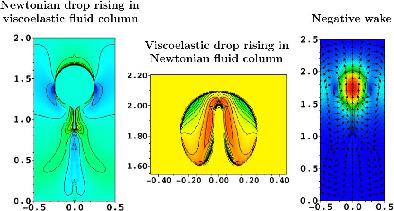当前位置:
X-MOL 学术
›
Int. J. Numer. Methods Fluids
›
论文详情
Our official English website, www.x-mol.net, welcomes your
feedback! (Note: you will need to create a separate account there.)
Finite element computations of viscoelastic two‐phase flows using local projection stabilization
International Journal for Numerical Methods in Fluids ( IF 1.7 ) Pub Date : 2020-02-03 , DOI: 10.1002/fld.4808 Jagannath Venkatesan 1 , Sashikumaar Ganesan 1
International Journal for Numerical Methods in Fluids ( IF 1.7 ) Pub Date : 2020-02-03 , DOI: 10.1002/fld.4808 Jagannath Venkatesan 1 , Sashikumaar Ganesan 1
Affiliation

|
A three‐field local projection stabilized (LPS) finite element method is developed for computations of a three‐dimensional axisymmetric buoyancy driven liquid drop rising in a liquid column where one of the liquid is viscoelastic. The two‐phase flow is described by the time‐dependent incompressible Navier‐Stokes equations, whereas the viscoelasticity is modeled by the Giesekus constitutive equation in a time‐dependent domain. The arbitrary Lagrangian‐Eulerian (ALE) formulation with finite elements is used to solve the governing equations in the time‐dependent domain. Interface‐resolved moving meshes in ALE allows to incorporate the interfacial tension force and jumps in the material parameters accurately. A one‐level LPS based on an enriched approximation space and a discontinuous projection space is used to stabilize the numerical scheme. A comprehensive numerical investigation is performed for a Newtonian drop rising in a viscoelastic fluid column and a viscoelastic drop rising in a Newtonian fluid column. The influence of the viscosity ratio, Newtonian solvent ratio, Giesekus mobility factor, and the Eötvös number on the drop dynamics are analyzed. The numerical study shows that beyond a critical Capillary number, a Newtonian drop rising in a viscoelastic fluid column experiences an extended trailing edge with a cusp‐like shape and also exhibits a negative wake phenomena. However, a viscoelastic drop rising in a Newtonian fluid column develops an indentation around the rear stagnation point with a dimpled shape.
中文翻译:

使用局部投影稳定化的粘弹性两相流有限元计算
开发了一种三场局部投影稳定(LPS)有限元方法,用于计算在其中一种液体是粘弹性的液柱中上升的三维轴对称浮力驱动的液滴。两相流由时间相关的不可压缩Navier-Stokes方程描述,而粘弹性由Giesekus本构方程在时间相关的域中建模。具有有限元的任意拉格朗日-欧拉(ALE)公式用于求解时变域中的控制方程。ALE中的界面解析运动网格允许合并界面张力并准确地跳跃材料参数。基于丰富的逼近空间和不连续的投影空间的单级LPS用于稳定数值方案。对在粘弹性流体塔中上升的牛顿液滴和在牛顿流体塔中上升的粘弹性液滴进行了全面的数值研究。分析了粘度比,牛顿溶剂比,Giesekus迁移率因子和Eötvös数对液滴动力学的影响。数值研究表明,在临界毛细管数以上,粘弹性流体柱中上升的牛顿液滴的后缘呈尖峰状,并表现出负的尾流现象。然而,在牛顿流体柱中上升的粘弹性液滴在后停滞点周围形成凹陷形状的凹痕。分析了粘度比,牛顿溶剂比,Giesekus迁移率因子和Eötvös数对液滴动力学的影响。数值研究表明,在临界毛细管数以上,粘弹性流体柱中上升的牛顿液滴的后缘呈尖峰状,并表现出负的尾流现象。然而,在牛顿流体柱中上升的粘弹性液滴在后停滞点周围形成凹陷形状的凹痕。分析了粘度比,牛顿溶剂比,Giesekus迁移率因子和Eötvös数对液滴动力学的影响。数值研究表明,在临界毛细管数以上,粘弹性流体柱中上升的牛顿液滴的后缘呈尖峰状,并表现出负的尾流现象。然而,在牛顿流体柱中上升的粘弹性液滴在后停滞点周围形成凹陷形状的凹痕。在粘弹性流体柱中升起的牛顿液滴会出现后缘扩展,呈尖顶状,并表现出负的尾流现象。然而,在牛顿流体柱中上升的粘弹性液滴在后停滞点周围形成凹陷形状的凹痕。在粘弹性流体柱中升起的牛顿液滴会出现后缘扩展,呈尖顶状,并表现出负的尾流现象。然而,在牛顿流体柱中上升的粘弹性液滴在后停滞点周围形成凹陷形状的凹痕。
更新日期:2020-02-03
中文翻译:

使用局部投影稳定化的粘弹性两相流有限元计算
开发了一种三场局部投影稳定(LPS)有限元方法,用于计算在其中一种液体是粘弹性的液柱中上升的三维轴对称浮力驱动的液滴。两相流由时间相关的不可压缩Navier-Stokes方程描述,而粘弹性由Giesekus本构方程在时间相关的域中建模。具有有限元的任意拉格朗日-欧拉(ALE)公式用于求解时变域中的控制方程。ALE中的界面解析运动网格允许合并界面张力并准确地跳跃材料参数。基于丰富的逼近空间和不连续的投影空间的单级LPS用于稳定数值方案。对在粘弹性流体塔中上升的牛顿液滴和在牛顿流体塔中上升的粘弹性液滴进行了全面的数值研究。分析了粘度比,牛顿溶剂比,Giesekus迁移率因子和Eötvös数对液滴动力学的影响。数值研究表明,在临界毛细管数以上,粘弹性流体柱中上升的牛顿液滴的后缘呈尖峰状,并表现出负的尾流现象。然而,在牛顿流体柱中上升的粘弹性液滴在后停滞点周围形成凹陷形状的凹痕。分析了粘度比,牛顿溶剂比,Giesekus迁移率因子和Eötvös数对液滴动力学的影响。数值研究表明,在临界毛细管数以上,粘弹性流体柱中上升的牛顿液滴的后缘呈尖峰状,并表现出负的尾流现象。然而,在牛顿流体柱中上升的粘弹性液滴在后停滞点周围形成凹陷形状的凹痕。分析了粘度比,牛顿溶剂比,Giesekus迁移率因子和Eötvös数对液滴动力学的影响。数值研究表明,在临界毛细管数以上,粘弹性流体柱中上升的牛顿液滴的后缘呈尖峰状,并表现出负的尾流现象。然而,在牛顿流体柱中上升的粘弹性液滴在后停滞点周围形成凹陷形状的凹痕。在粘弹性流体柱中升起的牛顿液滴会出现后缘扩展,呈尖顶状,并表现出负的尾流现象。然而,在牛顿流体柱中上升的粘弹性液滴在后停滞点周围形成凹陷形状的凹痕。在粘弹性流体柱中升起的牛顿液滴会出现后缘扩展,呈尖顶状,并表现出负的尾流现象。然而,在牛顿流体柱中上升的粘弹性液滴在后停滞点周围形成凹陷形状的凹痕。











































 京公网安备 11010802027423号
京公网安备 11010802027423号